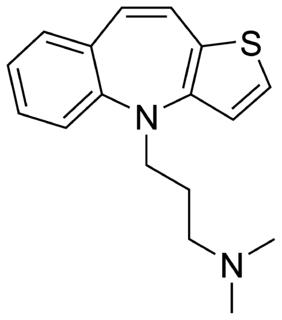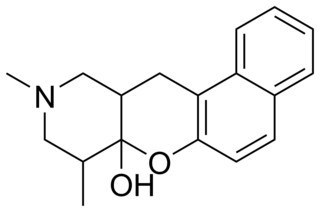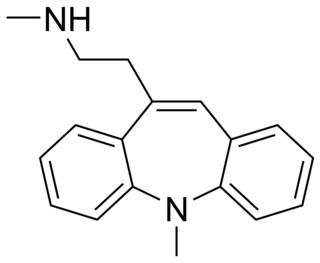
Tricyclic antidepressants (TCAs) are a class of medications that are used primarily as antidepressants. TCAs were discovered in the early 1950s and were marketed later in the decade. They are named after their chemical structure, which contains three rings of atoms. Tetracyclic antidepressants (TeCAs), which contain four rings of atoms, are a closely related group of antidepressant compounds.
There are many hundreds of thousands of possible drugs. Any chemical substance with biological activity may be considered a drug. This list categorises drugs alphabetically and also by other categorisations.

Fluacizine, sold under the brand name Phtorazisin, is a tricyclic antidepressant (TCA) of the phenothiazine group which is or was marketed in Russia. Unlike other phenothiazines, fluacizine is not an antipsychotic, and can actually reverse catalepsy and extrapyramidal symptoms induced by antidopaminergic agents like antipsychotics, reserpine, and tetrabenazine as well as potentiate amphetamine-induced stereotypy. It is known to act as a norepinephrine reuptake inhibitor, antihistamine, and anticholinergic. The drug was developed in the 1960s and was marketed in the 1970s. It is the trifluoromethyl analogue of chloracizine.

Hexoprenaline is a selective β2 adrenergic receptor agonist used in the treatment of asthma. Hexoprenaline is also used in some countries as a tocolytic agent, with the most common trade name being Gynipral. It is not approved by the United States Food and Drug Administration.

Alfetamine, or alpha-allyl-phenethylamine, is a chemical compound of the phenethylamine family. It was briefly investigated as a possible antidepressant in the early 1970s. Its activity profile was said to be very similar to imipramine and amitriptyline, two tricyclic antidepressants. It has now been largely superseded by the newer compounds in this class, and only rarely found in scientific literature. The "alpha" in its name refers to its prodrug form, alfetamine. In addition to being an antidepressant, alfetamine is also a neuroprotective agent that acts as a weak dopamine antagonist and a high affinity κ-opioid receptor agonist.

Tandamine is a selective norepinephrine reuptake inhibitor with a tricyclic structure. It was developed in the 1970s as an antidepressant but was never commercialized. Tandamine is analogous to pirandamine, which, instead, acts as a selective serotonin reuptake inhibitor (SSRI).

Propizepine is a tricyclic antidepressant (TCA) used in France for the treatment of depression which was introduced in the 1970s.

Intriptyline is a tricyclic antidepressant (TCA) that was never marketed.

Octriptyline (SC-27,123) is a tricyclic antidepressant (TCA) that was never marketed.GB 1406481.

Azepindole (McN-2453) is a tricyclic compound with antidepressant and antihypertensive effects that was developed in the late 1960s but was never marketed.

Fluotracen (SKF-28,175) is a tricyclic drug which possesses dual antidepressant and antipsychotic activity. This profile of effects is similar to that of related agents like amoxapine, loxapine, and trimipramine which may also be used in the treatment of both depression and psychosis. It was believed that such duality would be advantageous in the treatment of schizophrenia, as depression is often comorbid with the disorder and usual antipsychotics often worsen such symptoms. In any case, however, fluotracen was never marketed.

Tienopramine is a tricyclic antidepressant (TCA) which was never marketed. It is an analogue of imipramine where one of the benzene rings has been replaced with a thiophene ring.

Mariptiline (EN-207) is a tricyclic antidepressant (TCA) which was developed in the early 1980s, but was never marketed.

Homopipramol is a tricyclic antidepressant and antipsychotic which was never marketed.

Mezepine is a tricyclic antidepressant (TCA) that was never marketed.

Naranol (W-5494A) is a drug with a tricyclic-like structure. It was synthesized in the late 1960s, and was reported to have antidepressant, anxiolytic, and antipsychotic properties, but was never marketed.

Enprazepine is a tricyclic antidepressant (TCA) which was never marketed.

Depramine, also known as balipramine (BAN) and as 10,11-dehydroimipramine, is a tricyclic antidepressant (TCA) which was never marketed.

Amezepine is a tricyclic antidepressant (TCA) which was never marketed.

Tiazesim (INN), or thiazesim, previously sold under the brand name Altinil, is a heterocyclic antidepressant related to the tricyclic antidepressants (TCAs) which, first introduced in 1966 by Squibb Corporation, has since been discontinued and is no longer marketed.



















